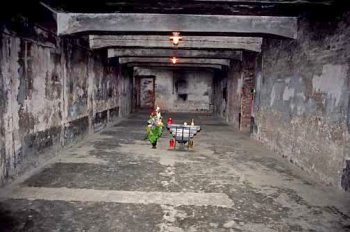The “gas chamber” of Auschwitz-I
Since 1948, the year the Auschwitz State Museum was founded by the Polish communists, millions of tourists have visited the crematorium of the main camp (Auschwitz-I) with its “gas chamber” (500,000 visitors per year in the early 1990’s).
That crematorium and that “gas chamber” are presented by the guides as genuine, but recalcitrant visitors who put questions to the authorities have been told, since my own visits of 1975 and 1976, that it is in fact a “reconstruction” (understood to be an identical replica of the original). In reality, the whole is neither genuine nor an identical replica of the original. In 1941-42, it was the most conventional of crematoria with, especially, a cold room for the corpses and an incineration block with six ovens; in 1943-44, the six ovens were done away with and the cold room, along with other parts of the building, were transformed into an air-raid shelter with a surgical operating room serving the nearby SS hospital.
I made these discoveries in 1975/1976 and published the subsequent results from 1978 to1980.
Éric Conan
Fifteen years afterwards, the reporter-historian Éric Conan, although quite hostile to revisionism, published in the Express (Paris) of 19-25 January 1995 a lengthy study, Auschwitz : la mémoire du mal, in which he denounced the falsifications of the crematorium and its “gas chamber”. Concerning this point, here are the findings of his inquiry, to certain words of which I add emphasis:
In 1948, during the museum’s creation, crematorium I was reconstituted in its supposed original state. Everything in it is false: the gas chamber’s dimensions, the location of the doors, the openings for the pouring in of the Zyklon B, the ovens, rebuilt according to what some survivors remembered, the height of the chimney. In the late 1970’s, Robert Faurisson exploited these falsifications all the better as the museum administration balked at acknowledging them (p. 68).
É. Conan questioned a museum official about what he calls a “misrepresentation” and about what, according to him, Théo Klein, former president of the CRIF, the “representative council of Jewish organisations of France”, calls an “artifice”:
Krystyna Oleksy, whose director’s office, which occupies the old SS hospital, looks straight out on to crematorium I, has not resigned herself [to telling the truth about the gas chamber]: “For the time being, it is to be left ‘as is’, with nothing specified to the visitor. It’s too complicated. We’ll see later on.”
This person’s reply amounts to saying: “We have lied. We are lying. And, until further notice, we shall continue to lie.”
Robert Jan van Pelt and Debórah Dwork
In 1996 two historians of Jewish origin, the Canadian Robert Jan van Pelt and the American Debórah Dwork, devoted a work to the history of Auschwitz, from 1270 AD (year of the town’s founding) to current times (Auschwitz / 1270 to the Present, published in London by Yale University Press, 1996, 443 p.). They in turn state that the authorities at the Auschwitz State Museum have proceeded to make alterations, transformations, and falsifications of the Auschwitz I site as concerns both the detainees’ reception building and crematorium I with its “gas chamber”. The authors use the following words: “postwar obfuscation”, “additions”, “deletions”, “suppression”, “reconstruction”, “largely a postwar reconstruction” (p. 363), “reconstructed”, “usurpation”, “re-created” (p. 364), “falsified” (p. 367), “falsifying” (p. 369).
On the subject of the gas chamber they write:
[After the war] four hatched openings in the roof, as if for pouring Zyklon B into the gas chamber below, were installed (p. 364).
They point out that no sign calls the public’s attention to any changes, on which…
… the guides remain silent […] when they take the visitors through this building that is presumed by the tourist to be the place where it happened (ibid.).
Appeal to UNESCO
The entire Auschwitz complex is registered by UNESCO as a protected world heritage site. Some countries of the Arab-Islamic world, irritated by the prosecution in France of Roger Garaudy for having called the gas chambers into question, could, if the latter were convicted on February 27, 1998, bring an action at UNESCO for the case of the emblematic “gas chamber” at Auschwitz; they might, at the same occasion, demand a forensic examination of the remains of the gas chamber at Auschwitz-Birkenau’s crematorium II; the caved-in roof of this gas chamber has visibly never possessed any of the four special 25 by 25 cm (97⁄8 in.) holes which, we are told, were meant to allow the pouring in of the Zyklon B pellets. That being the case, how could an execution gassing operation simply have begun?
January 26, 1998

